 Lowcountry Basket Makers, oil, 12" x 16" Lowcountry Basket Makers, oil, 12" x 16" Last year I joined the artist organization Preserving a Picturesque America (PAPA). This non-profit organization seeks to preserve historical, cultural and natural locations originally depicted in the 1800s publication Picturesque America. We do this by making paintings of these places as they are today and raising awareness and funds through art exhibition sales with proceeds that go to groups that help protect them. My artwork has been selected by jury review to be in a show at the beautiful Charleston exhibit space near the Pineapple Fountain, City Gallery. The artists who created the organization, Scott “Doc” Varn and team, researched and traveled extensively for years to find the exact locations originally painted by publication artists. He and a co-host were followed in a PBS documentary, America, The Land We Live In, as they braved arduous hikes and river rapids as well as genteel Charleston homes seeking to match the views of topography and structures. What interests me is not just the visual beauty of these places, but the stories of the past 150 years represented by the landmarks. PAPA hosts paint-outs at the locations several times a year and I have attended a couple of them. My painting, “An Old Live Oak” was started on site at Drayton Hall at one of the events, and later finished in the studio. The other painting I did for the exhibit, “Lowcountry Basket Makers”, was composed in my studio using reference photos taken during a paint-out event in Mt. Pleasant and supplied by the organization. The member artists and photographers are encouraged to work in their own styles and media, and in exhibits this diversity of creativity brings visual interest and liveliness to the theme of representation. The “Preservation Through Art—Charleston” exhibition will take place July 19th through September 8th at the City Gallery, 34 Prioleau Street, Charleston, SC 29401. PAPA will conduct a sale of art pieces in the exhibition to benefit community partners and their preservation efforts in the Charleston area. For more information go to: Preserving a Picturesque America or call 828-628-0006 ext.701.
0 Comments
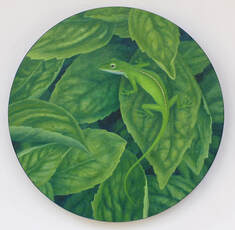 "Blending In", oil on panel, 8" diameter "Blending In", oil on panel, 8" diameter It's been a while since I participated in a juried show out of state, but I do enjoy themed exhibits when the subject is something I can relate to. This exhibit space in Norfolk, Virginia, has a regular practice of bringing together artworks in a variety of media and styles that represent different approaches to a common subject. For this one they asked for art about animals and insects, and I happened to have a small painting of an anole hiding in a large basil plant that I completed a couple of years ago, a perfect contribution. The exhibit will be on view March 16 to April 13, 2024. See the entire exhibit here: Nature Homage: A Juried National Exhibition Artworks Featuring Animals & Insects from d'Art Center | Artwork Archive 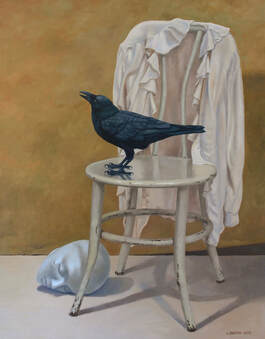 "Fallen Angel", oil on linen, 2005 "Fallen Angel", oil on linen, 2005 Some years ago, I made a series of paintings featuring animals in scenarios that mostly took them out of their natural habitats. Living in Seattle at the time, I visited the zoo and sketched animals there, as well as domestic and common creatures found at home and in public parks, and in reference photos. Then I combined the creatures in compositions with objects found in my studio or invented places. The largest painting, "Elephant", was 48" x 60" and the smallest, "Condor Chick", was 8" x 10". The paintings proved popular and most sold from the exhibit Fountainhead Gallery mounted for me. I recently decided to have prints made of some of the suitable image files and was pleased with the results. Working with a local printer, I am now offering a limited number of them for sale, printed with archival inks on fine art paper. I am also trying out having a store right here on my website, something else new to me. It is still a work in progress. I welcome you to take a look, try it out and let me know what you think! Over 100 artists came to Edisto Island October 11 to 14 for the fourth annual Plein Air Paint Out sponsored by the Edisto Art Guild. I was on the small committee that put it together and it was both fun and a challenge. The artists registered months in advance and on the morning of sign-in and stamping of painting supports they lined up with great enthusiasm. We had several private properties available to them for painting locations, as well as all the publicly available beauty of the island. The weather had been dry for weeks. Then the rains came! But artists are intrepid and adaptable, and they headed out anyway. Some brought umbrellas, others found shelter on porches and under elevated houses, some painted from their cars. I set up near my dock with my umbrella sheltering my easel from intermittent sprinkles, spending several hours painting as the tide went out. But on a gray day, at least the light does not change much!
This was the first year we had a "wet paint" exhibit and competition open to the public, held in the Edisto Beach Civic Center. Art materials suppliers sent us samples to give out and wonderful items and gifts certificates for prizes. Local businesses also donated money for awards and were supportive. The range and quality of artworks was impressive, and the judge noted this in her comments. The exhibit was well attended and many paintings were taken home by excited buyers. I confess I was glad when it was all over, but I am sure I won't be able to resist participating again next year! 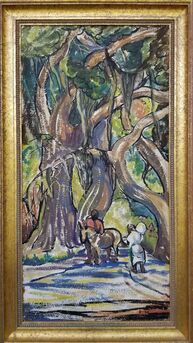 Faith Cornish Murray Faith Cornish Murray Currently hanging and on view until September 23 at the Edisto Island Museum is an exhibit that I put together with Museum Director Gretchen Smith of paintings by three generations of women in my family. As well as the artistic value of the art, the exhibit has historical significance as my maternal family has lived on Edisto since the 1770s. My grandmother, Faith Cornish Murray, (1897-1984) was born in Charleston and after marrying my grandfather discovered that their families were connected a few generations back, as many Edisto families are. While they lived in Charleston, she was a member of the art community during the “Charleston Renaissance,” a period of cultural renewal (1915-1940). She was one of the artists who were interested in and promoted exhibits of progressive and abstract art. Her own work was influenced by Cezanne, while still inspired by the landscape and people of the area. She was included in several exhibitions, including the 1939 World’s Fair in New York. Her work remains in the South Carolina State Museum, the Greenville (SC) Museum of Art and the Gibbes Museum of Art in Charleston. My mother, Faith Murray Britton, grew up on Edisto in the old house my grandfather and his father grew up in. She attended the innovative school Black Mountain College in North Carolina, where she studied with influential teachers such as Joseph Albers. She remained experimental in her approach to art all her life, and valued the use of imagination in creativity, a tool she needed growing up on a rural island with few other children or resources. Along with painting and sculpting, she wrote plays and made puppets, an activity she started as a child along with her sister, Jane Murray McCollum. My Aunt Jane was a nurse and had little formal training in art. She loved doing crafts and sewing, and later in life she devoted herself to watercolor painting. After she and her husband retired back to the old house on Edisto, she was active in volunteering in the local school, church and community while painting her beloved pets and scenes of Island life. With limited space and many of the older paintings in fragile shape, we weren’t able to display the full scope of the careers of my admirable foremothers, but I was able to obtain some wonderful examples. I included a few of my own pieces that I hope relate in subject if not style. Art—A Family Tradition is at the Edisto Museum, 8123 Chisolm Plantation Road, Edisto Island, SC 29438, until September 23, 2023. Museum hours are Tuesday – Saturday, 12 to 5 p.m. Call 843-869-1954 for more information. 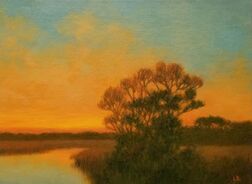 Sunset Study II, oil, 6" x 8" (sold) Sunset Study II, oil, 6" x 8" (sold) Since the beginning of June, a few of my paintings have been on display at the Charleston Artist Guild Gallery, located in the heart of the historic district of Charleston, SC. This nonprofit organization has been around since 1953 with a mission to promote the practice, teaching and recognition of Fine Arts in the Charleston area. The gallery exhibits the work of over 70 of the members, showing paintings, photographs, drawings and mixed media art in a range of prices. We members share the rent and have gallery-sitting and other duties. I plan to participate and provide fresh art on a regular basis throughout the next year. I recently took my first shift working at the gallery, on a blustery beginning-of-summer day. It is a bit of a long drive from Edisto Island, but always a treat to be on “the peninsula” among the beautiful old buildings. Charleston is full of tourists now, and many stopped by to peruse our diverse assortment of artworks. Most came as couples and family groups. I was impressed that several parents were preceded by their children, eager young art afficionados who were serious in their interest. I hope they will become the next generation of art patrons and creators and am glad our gallery has an atmosphere that welcomes them. Like some other galleries in this area, CAG allows a “salon style” of exhibit design. Wall space in the seven rooms is filled almost floor to ceiling. While this tight spacing may not present an individual painting as effectively as a more austere arrangement that imbues each work with importance, it creates an unpretentious atmosphere. Perhaps at the risk of being overwhelmed, viewers are given plenty of choices. I display four of my small landscape paintings in my wall area and was pleased to have “Sunset Study II” go home with a buyer early on. I hope that trend continues. Along with the ongoing, constantly evolving exhibit of affordable art, CAG gallery has a featured artist each month and participates in the monthly First Friday Artwalk from 5 to 8 p.m. on scheduled dates. The gallery is located at 160 East Bay Street, Charleston, SC, open daily from 11 to 5. The phone number is 843-722-2425. Gallery information and images of works by the member artists are online here: Charleston Artist Guild Gallery Fine Art 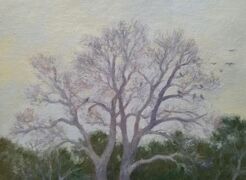 View from studio window View from studio window The month of January is quiet on Edisto Island. There are few tourists and local businesses are open fewer hours or closed for a respite, like the farm stand. The weather has been dreary and damp, interspersed with bouts of sun and rainstorms, but fortunately without the ice and snow much of the country has faced. The colors of the landscape are muted and grayer than in typical winters, due to a hard freeze in December. I was on an enforced hiatus from some of my usual outdoor activities, including plein air painting, for several weeks of this winter due to a broken ankle. I re-read some of my library of art books, as well as many novels. I am back on my feet now and painting and drawing daily, mostly inside the studio for the time being. I’ve been looking over unfinished plein air sketches from 2022 with a critical eye, reworking some of them, and painting small landscape scenes from imagination. February 3 will see a refreshed painting exhibit at Edisto Fine Art with a “First Friday” reception from 5 to 7 p.m. The address is 805 Oyster Park Drive and the gallery is inside Indigo. Come by for a glass of wine and a visit, and remember you are welcome to contact me if you would like to see any of the works on this website in person. I would be happy to bring them into the gallery or meet you at my studio. 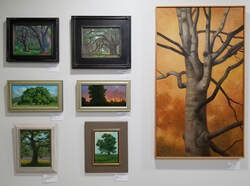 The month of November the theme at Edisto Fine Art is paintings of trees, a subject very familiar to landscape painters, and especially dear to my heart. You will see more examples on the walls throughout Indigo, the decor shop that houses the gallery located at 805 Oyster Park Drive on Edisto Island, SC. The live oak trees of the South are a subject as challenging to the painter as they are appealing, as the crown often spreads twice as wide as the tree is tall, with complex networks of branches and openings. They often have a multi-trunked structure, and branches reach horizontally, sometimes touching the ground and then arcing back up, even growing roots there given time. This spreading nature helps them withstand and survive hurricane winds. The twisting forms of the branches are obscured and softened by resurrection fern and Spanish moss, which is actually an air plant. Ubiquitous mop-like palmettos (Sabal palm, the state tree of South Carolina) present their own challenges. When I draw or paint trees, I sometimes try to capture the mass of the crown of foliage, but I am most interested in how the trunk and branches relate to the structure of the human or animal body. They form an armature for the leaves which is like the bones and muscles of a creature, become gnarled with age, and the bark bears the scars of wounds received. We are open Wednesday through Saturday, 10 to 5, and artist Nancy Zydler is often in the gallery at her easel. Stop by and say hello! 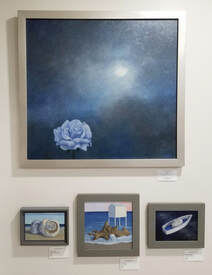 For the month of October, the theme at Edisto Fine Art is "Mysteries", for which I have hung a few of my more surrealistic paintings along with assemblage and sculptural works. The gallery is located inside Indigo home decor store, 805 Oyster Park Drive, and is open Wednesday through Saturday, 11 to 5. My means of expression is realistic, but I am drawn to images that are less straightforward and I create these when I am able. As I wrote in my artist's statement for an exhibit a few years ago, "These paintings are part of my ongoing investigation into the border between reality and imagination as it applies to nature scenes. The dream, daydream, meditation, or fleeting thought at the edge of perception can paradoxically put us more in touch with our surroundings." 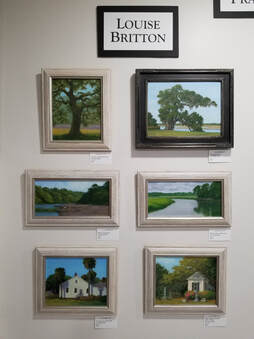 I have a new set of small paintings up for the rest of the month of September at Edisto Fine Art, inside home and decor shop Indigo. The gallery is located on Oyster Factory Road (Edisto Island, SC) and open Wednesday through Saturday from 11 to 5. We launched the exhibit with a well-attended wine and food reception on Friday, September 2, and plan to have new work up with an opening for the public the first Friday of each month to come. Look for an announcement about October's theme. We have been enjoying a bit of cooler, drier weather with the start of Fall. The light angle is changing, the greens of the trees are becoming more subtle, the marsh is yellow-gold, and it is a lovely time of year for plein air painting! |
AuthorHere I will keep you up to date on my exhibits and other artistic endeavors. Archives
March 2024
Categories |
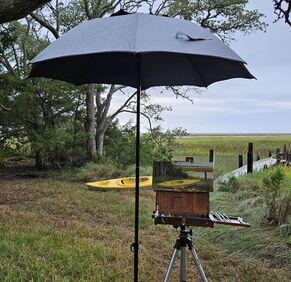
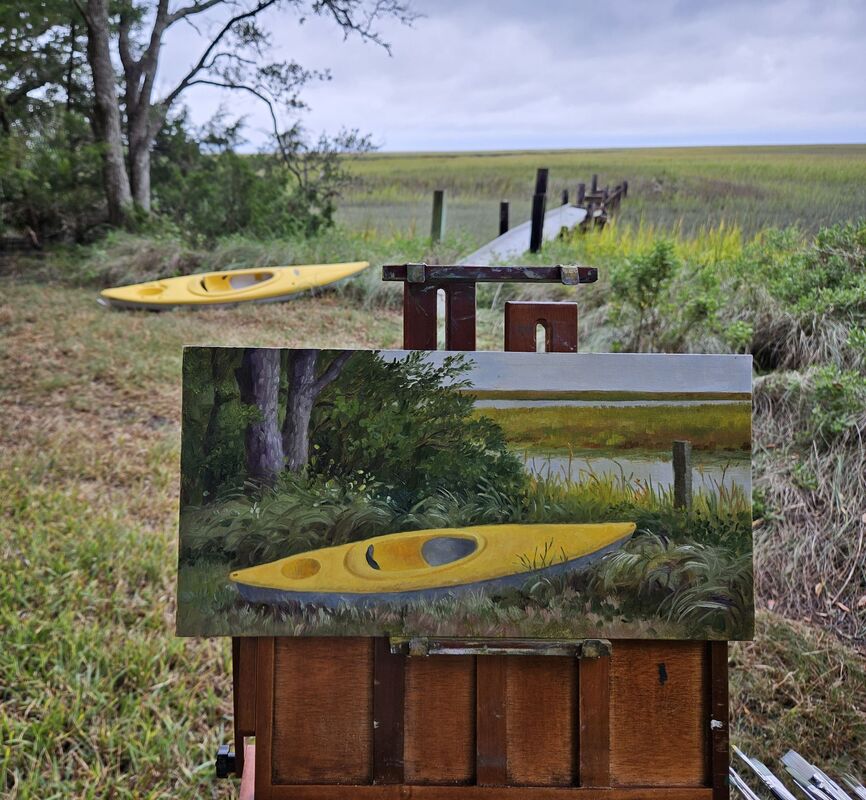
 RSS Feed
RSS Feed